The Mechanical Properties and Chloride Resistance of Concrete Reinforced with Hybrid Polypropylene and Basalt Fibres
Abstract
:1. Introduction
2. Experimental Program
2.1. Materials
2.2. Mix Proportions
2.3. Test Procedure
3. Result and Discussion
3.1. Slump of Fresh Concrete
3.2. Compressive Strength.
3.3. Splitting Tensile Strength and Flexural Strength.
3.4. The Synergy of PP and BF
3.5. Chloride Resistance
3.6. Morphology
3.7. Pore Structure
4. Conclusions
- The hybridization of PP and BF has no significant influence on the workability of concrete compared to the single fibres at the same content.
- The combination of PP and BF can improve the compressive, splitting tensile and flexural strength of concrete in comparison to the individual fibres. However, the hybridization is not always conductive, and it has positive and negative synergistic effects at different volume proportions. It is suggested that the total hybrid fibre volume content should be no more than 0.3%, and the volume content of the single BF should be no more than 0.1%. In this paper, the optimum combination is 0.1% PP and 0.1% BF by volume of concrete, and the compressive, splitting tensile and flexural strength were improved by 4.74, 43.65 and 18.98% compared with those of no-fibre concrete, respectively.
- Incorporating fibres reduced the chloride resistance of concrete, and a more obvious reduction was observed when adding PP in comparison to adding BF. The hybridization of the two fibres does not enhance this phenomenon; however, the reduction was intensified at high hybrid fibre volume. Increasing the curing age can mitigate the adverse effect on the chloride resistance of concrete caused by fibres.
- The addition of PP and BF, singly or in hybridization, increases the cumulative pore volume and porosity of concrete. The fibres transform the original pore structure and changes small-size pores into large-size pores. Moreover, the hybridization of fibres can improve the pore size distribution in the concrete compared with the single fibres at the same volume.
Author Contributions
Funding
Conflicts of Interest
References
- Metha, P.K.; Monteiro, P.J.M. Concrete: Microstructure, Properties and Materials, 3rd ed.; McGraw-Hill: New York, NY, USA, 2006. [Google Scholar]
- Shaikh, F.U.A. Review of mechanical properties of short fibre reinforced geopolymer composites. Constr. Build. Mater. 2013, 43, 37–49. [Google Scholar] [CrossRef]
- Tassew, S.T.; Lubell, A.S. Mechanical properties of glass fiber reinforced ceramic concrete. Constr. Build. Mater. 2014, 51, 215–224. [Google Scholar] [CrossRef]
- Mohammadi, Y.; Singh, S.P.; Kaushik, S.K. Properties of steel fibrous concrete containing mixed fibres in fresh and hardened state. Constr. Build. Mater. 2008, 22, 956–965. [Google Scholar] [CrossRef]
- Şanal, İ.; Özyurt, N.; Hosseini, A. Characterization of hardened state behavior of self compacting fiber-reinforced cementitious composites (SC-FRCC’s) with different beam sizes and fiber types. Compos. Part B Eng. 2016, 105, 30–45. [Google Scholar] [CrossRef]
- Romualdi, J.P.; Mandel, J.A. Tensile strength of: Concrete affected by uniformly distributed closely spaced short lengths of wire reinforcement. ACI J. Proc. 1964, 61, 657–671. [Google Scholar]
- Zollo, R.F. Fiber-reinforced concrete: An overview after 30 years of development. Cem. Concr. Compos. 1997, 19, 107–122. [Google Scholar] [CrossRef]
- Wecharatana, M.; Shah, S.P. A model for predicting fracture resistance of fiber reinforced concrete. Cem. Concr. Res. 2016, 13, 819–829. [Google Scholar] [CrossRef]
- Smarzewski, P. Influence of basalt-polypropylene fibres on fracture properties of high performance concrete. Compos. Struct. 2019, 209, 23–33. [Google Scholar] [CrossRef]
- Banthia, N.; Gupta, R. Hybrid fiber reinforced concrete (HyFRC): Fiber synergy in high strength matrices. Mater. Struct. 2004, 37, 707–716. [Google Scholar] [CrossRef]
- Caggiano, A.; Gambarelli, S.; Martinelli, E.; Nisticò, N.; Pepe, M. Experimental characterization of the post-cracking response in Hybrid Steel/Polypropylene Fiber-Reinforced concrete. Constr. Build. Mater. 2016, 125, 1035–1043. [Google Scholar] [CrossRef]
- Qian, C.X.; Stroeven, P. Development of hybrid polypropylene-steel fibre-reinforced concrete. Cem. Concr. Res. 2000, 30, 63–69. [Google Scholar] [CrossRef]
- Monteiro, V.M.A.; Lima, L.R.; Silva, F.A. On the mechanical behavior of polypropylene, steel and hybrid fiber reinforced self-consolidating concrete. Constr. Build. Mater. 2018, 188, 280–291. [Google Scholar] [CrossRef]
- Shan, L.; Zhang, L.; Xu, L. Experimental investigations on mechanical properties of hybrid steel-polypropylene fiber-reinforced concrete. Appl. Mech. Mater. 2014, 638, 1550–1555. [Google Scholar] [CrossRef]
- Farhad, A.; Shami, N. Self-compacting concrete incorporating steel and polypropylene fibers: Compressive and tensile strengths, moduli of elasticity and rupture, compressive stress-strain curve, and energy dissipated under compression. Compos. Part B Eng. 2013, 53, 121–133. [Google Scholar] [CrossRef]
- Vahid, A.; Togay, O. Mechanical and durability properties of high-strength concrete containing steel and polypropylene fibers. Constr. Build. Mater. 2015, 94, 73–82. [Google Scholar] [CrossRef]
- Fuat, K.; Osman, G.; Burhan, U.; Muhammed Yasin, D. Durability properties of concrete reinforced with steel-polypropylene hybrid fibers. Sci. Eng. Compos. Mater. 2012, 19, 19–27. [Google Scholar] [CrossRef]
- Qian, C.X.; Stroeven, P. Fracture properties of concrete reinforced with steel-polypropylene hybrid fibres. Cem. Concr. Compos. 2000, 22, 343–351. [Google Scholar] [CrossRef]
- Song, P.S.; Wu, J.C.; Hwang, S.; Sheu, B.C. Statistical analysis of impact strength and strength reliability of steel–polypropylene hybrid fiber-reinforced concrete. Constr. Build. Mater. 2005, 19, 1–9. [Google Scholar] [CrossRef]
- Mo, K.H.; Yap, S.P.; Alengaram, U.J.; Jumaat, M.Z.; Bu, C.H. Impact resistance of hybrid fibre-reinforced oil palm shell concrete. Constr. Build. Mater. 2014, 50, 499–507. [Google Scholar] [CrossRef]
- Dawood, E.T.; Ramli, M. Mechanical properties of high strength flowing concrete with hybrid fiber. Constr. Build. Mater. 2012, 28, 193–200. [Google Scholar] [CrossRef]
- Sim, J.S.; Park, C.; Moon, D.Y. Characteristics of basalt fiber as a strengthening material for concrete structures. Compos. Part B Eng. 2005, 36, 504–512. [Google Scholar] [CrossRef]
- Jiang, C.H.; Fan, K.; Wu, F.; Chen, D. Experimental study on the mechanical properties and microstructure of chopped basalt fibre-reinforced concrete. Mater. Des. 2014, 58, 187–193. [Google Scholar] [CrossRef]
- Dias, D.P.; Thaumaturgo, C. Fracture toughness of geopolymeric concretes reinforced with basalt fibers. Cem. Concr. Compos. 2005, 27, 49–54. [Google Scholar] [CrossRef]
- Branston, J.; Das, S.; Kenno, S.Y.; Taylor, C. Mechanical behaviour of basalt fibre-reinforced concrete. Constr. Build. Mater. 2016, 124, 88–886. [Google Scholar] [CrossRef]
- Kabay, N. Abrasion resistance and fracture energy of concretes with basalt fiber. Constr. Build. Mater. 2014, 50, 95–101. [Google Scholar] [CrossRef]
- Li, W.M.; Xu, J.Y. Mechanical properties of basalt fiber reinforced geopolymeric concrete under impact loading. Mater. Sci. Eng. A 2014, 50, 95–101. [Google Scholar] [CrossRef]
- Wang, D.H.; Ju, Y.Z.; Shen, H.; Xu, L.B. Mechanical properties of high performance concrete reinforced with basalt fiber and polypropylene fiber. Constr. Build. Mater. 2019, 197, 464–473. [Google Scholar] [CrossRef]
- Fu, Q.; Niu, D.T.; Zhang, J.; Huang, D.G. Dynamic compressive mechanical behaviour and modelling of basalt-polypropylene fibre-reinforced concrete. Arch. Civ. Mech. Eng. 2018, 18, 914–927. [Google Scholar] [CrossRef]
- Shi, X.M.; Xie, N.; Fortune, K.; Gong, J. Durability of steel reinforced concrete in chloride environments: An overview. Constr. Build. Mater. 2012, 30, 125–138. [Google Scholar] [CrossRef]
- Susanto, T.; Bahador, S.D.; Yang, D.L.T.; Gjørv, O.E. Concrete with very high resistance to chloride ingress. Concr. Int. 2014, 36, 30–36. [Google Scholar]
- Vahid, A.; Luigi, B.; Monteiro, P.J.M. The effect of steel and polypropylene fibers on the chloride diffusivity and drying shrinkage of high-strength concrete. Compos. Part B Eng. 2018, 139, 84–96. [Google Scholar] [CrossRef]
- Algin, Z.; Ozen, M. The properties of chopped basalt fibre reinforced self-compacting concrete. Constr. Build. Mater. 2018, 186, 678–685. [Google Scholar] [CrossRef]
- Toutanji, H.; McNeil, S.; Bayasi, Z. Chloride permeability and impact resistance of polypropylene-fiber-reinforced silica fume concrete. Cem. Concr. Res. 1998, 28, 961–968. [Google Scholar] [CrossRef]
- Sadrmomtazi, A.; Tahmouresi, B.; Saradar, A. Effects of silica fume on mechanical strength and microstructure of basalt fiber reinforced cementitious composites (BFRCC). Constr. Build. Mater. 2018, 162, 321–333. [Google Scholar] [CrossRef]
- GB/T 50081-2002–Ministry of Housing and Urban-Rural Construction of the People’s Republic of China. Standard for Test Method of Mechanical Properties on Ordinary Concrete; China Building Industry Press: Beijing, China, 2003. [Google Scholar]
- Standard C1202-12–Standard Test Method for Electrical Indication of Concrete’s Ability to Resist Chloride Ion Penetration; ASTM: West Conshohocken, PA, USA, 2012.
- Yap, S.P.; Bu, C.H.; Alengaram, U.J.; Mo, K.H.; Jumaat, M.Z. Flexural toughness characteristics of steel–polypropylene hybrid fibre-reinforced oil palm shell concrete. Mater. Des. 2014, 57, 652–659. [Google Scholar] [CrossRef]
- Sadrinejad, I.; Madandoust, R.; Ranjbar, M.M. The mechanical and durability properties of concrete containing hybrid synthetic fibers. Constr. Build. Mater. 2018, 178, 72–82. [Google Scholar] [CrossRef]
- Chen, B.; Liu, J.Y. Contribution of hybrid fibres on the properties of the high-strength lightweight concrete having good workability. Cem. Concr. Res. 2005, 35, 913–917. [Google Scholar] [CrossRef]
- Banthia, N.; Soleimani, S.M. Flexural response of hybrid fiber-reinforced cementitious composites. ACI Mater. J. 2005, 102, 382–390. [Google Scholar]
- Sun, J.Y. Study on performance of hybrid polypropylene fiber concrete. Concrete 2003, 11, 16–20. [Google Scholar] [CrossRef]
- Borhan, T.M. Thermal and mechanical properties of basalt fibre-reinforced concrete. World Acad. Sci. Eng. Technol. 2013, 7, 334–337. [Google Scholar] [CrossRef]
- Wang, J.; Zhang, Y. Experimental research on mechanical and working properties of non-dipping chopped basalt fiber reinforced concrete. In Proceedings of the 3rd International Conference on Information Management, Innovation Management and Industrial Engineering, Kunming, China, 26–28 November 2010; pp. 635–637. [Google Scholar] [CrossRef]
- Sivakumar, A.; Santhanam, M. Mechanical properties of high strength concrete reinforced with metallic and non-metallic fibers. Cem. Concr. Compos. 2007, 29, 603–608. [Google Scholar] [CrossRef]
- Song, P.S.; Hwang, S.; Sheub, B.C. Strength properties of nylon-and polypropylene fiber-reinforced concretes. Cem. Concr. Res. 2005, 35, 1546–1550. [Google Scholar] [CrossRef]
- Yurtseven, A.E.; Yaman, I.O.; Tokyay, M. Mechanical properties hybrid fibre-reinforced concrete. Monit. Model Concr. Prop. 2006, 207–214. [Google Scholar] [CrossRef]
- Hua, Y.; Zeng, Y. Experimental study on hybrid fibre effect. China Concr. Cem. Prod. 1998, 4, 45–49. [Google Scholar] [CrossRef]
- Wang, C.Q.; Wu, K.R. Research on the hybrid effect of different geometrical size hybrid fiber reinforced concrete. J. Build. Mater. 2005, 8, 250–255. [Google Scholar] [CrossRef]
- Luo, B.B.; Bi, Q.W. Experimental Study on the Influence of Pore Structure of Hybrid Fibers Self-compacting Concrete on Compressive Strength. Bull. Chin. Ceram. Soc. 2012, 31, 626–630. [Google Scholar]
- Susanto, T.; Vahid, A.; Ostertag, C.P. Flexural behavior and durability properties of high performance hybrid-fiber-reinforced concrete. Constr. Build. Mater. 2018, 182, 504–515. [Google Scholar] [CrossRef]
- Gong, J.X.; Guo, Y.X. Experimental study on impermeability of polypropylene fiber high performance concrete. New Build. Mater. 2006, 50–52. [Google Scholar] [CrossRef]
- Zhang, J.Z.; Bian, F.; Zhang, Y.R. Effect of pore structures on gas permeability and chloride diffusivity of concrete. Constr. Build. Mater. 2018, 163, 402–413. [Google Scholar] [CrossRef]
- Deng, S.H.; Zhang, J.; Tang, J.Z.; Xu, B.G. Influence of fiber on concrete permeability and pore structure of hard cement paste. Port. Ind. Technol. 2007, 3, 34–37. [Google Scholar] [CrossRef]
- Guo, Y.H.; Hu, X.Y.; Lv, J.F. Experimental study on the resistance of basalt fibre-reinforced concrete to chloride penetration. Constr. Build. Mater. 2019, 223, 142–155. [Google Scholar] [CrossRef]
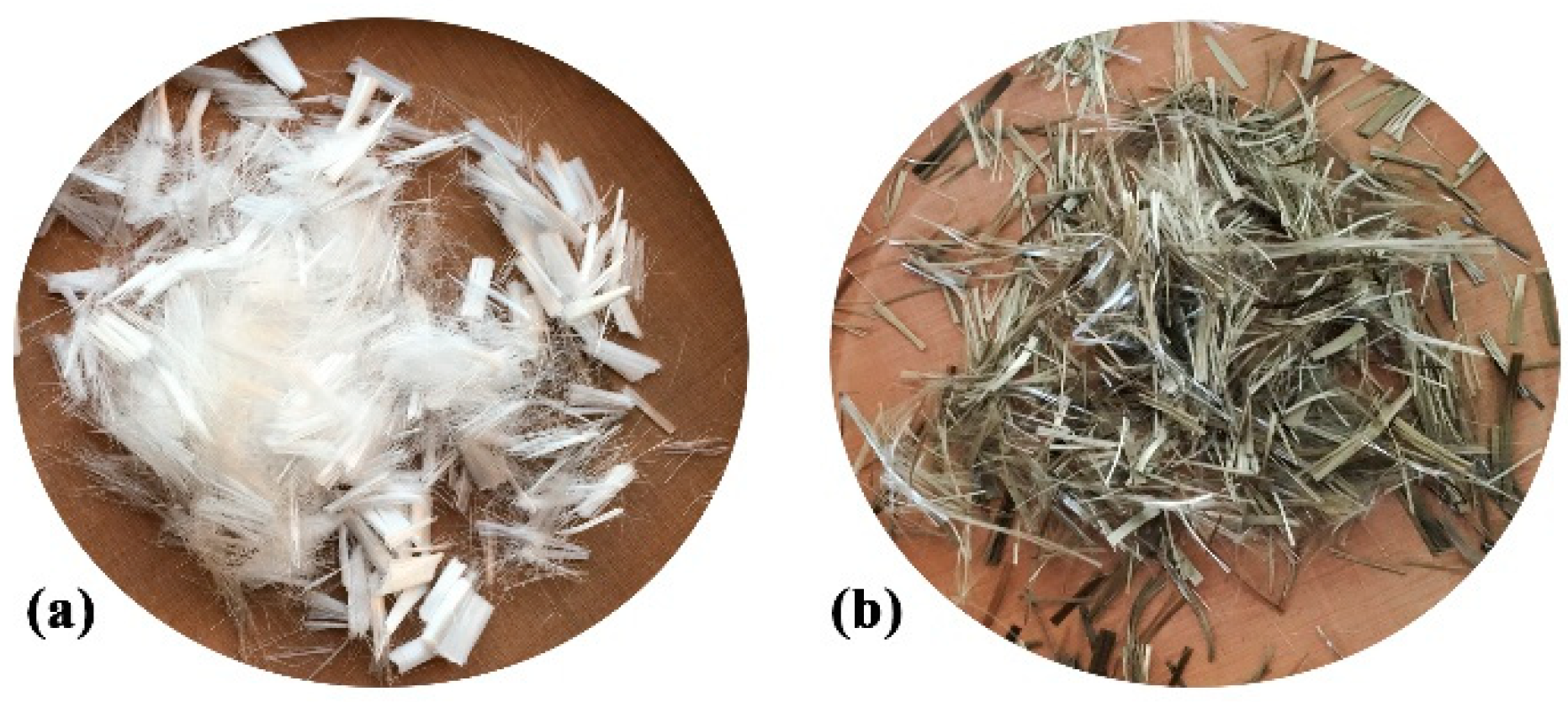
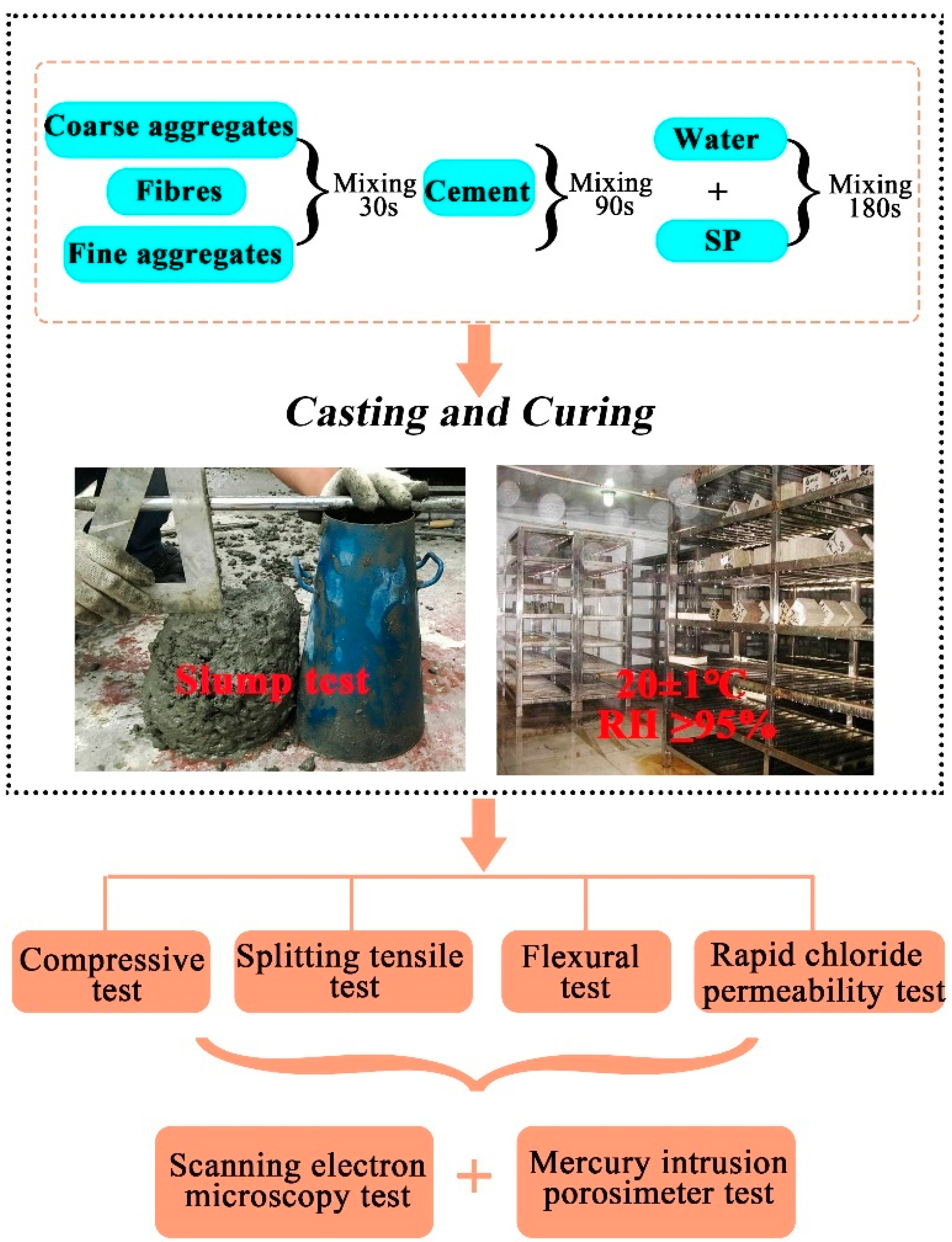
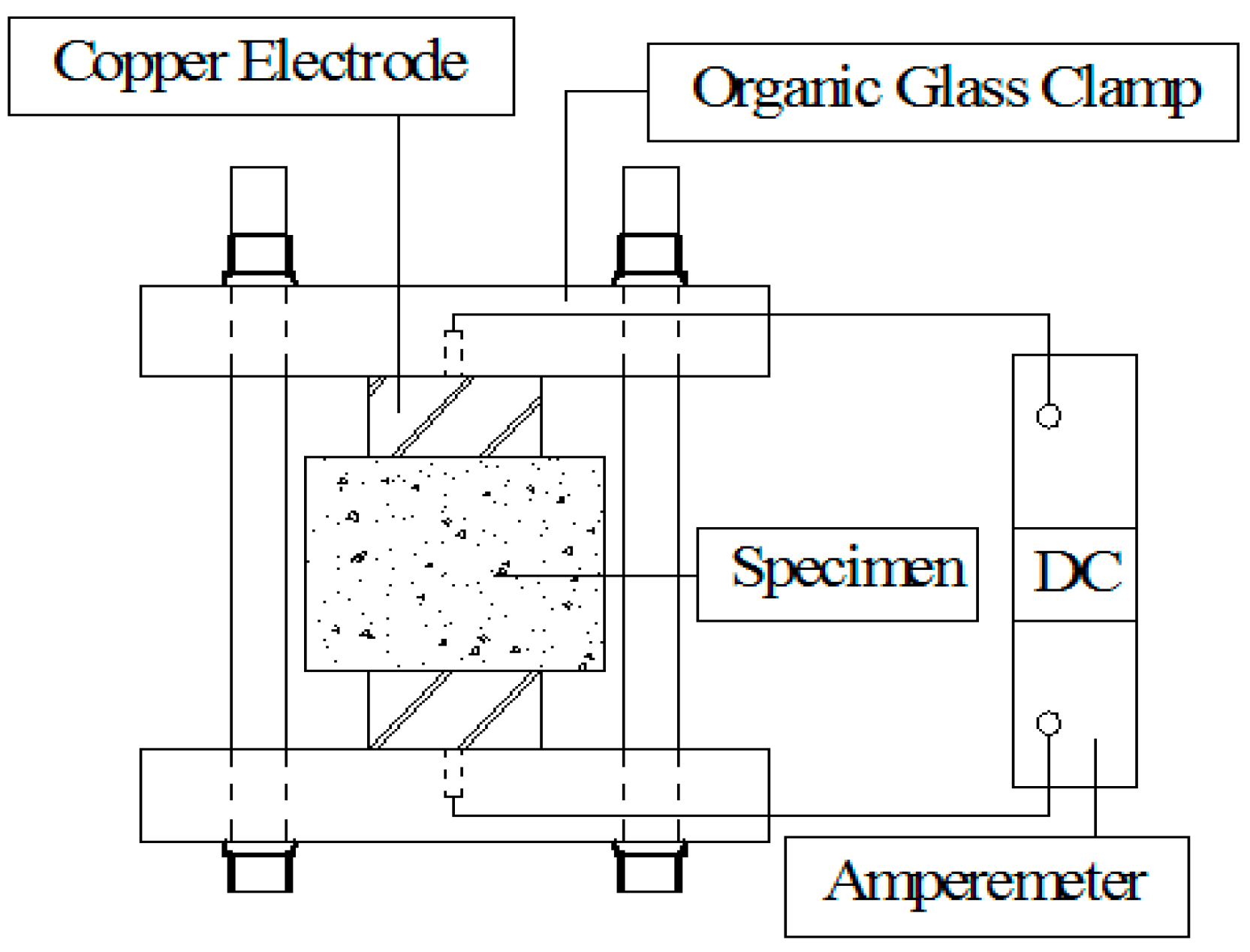
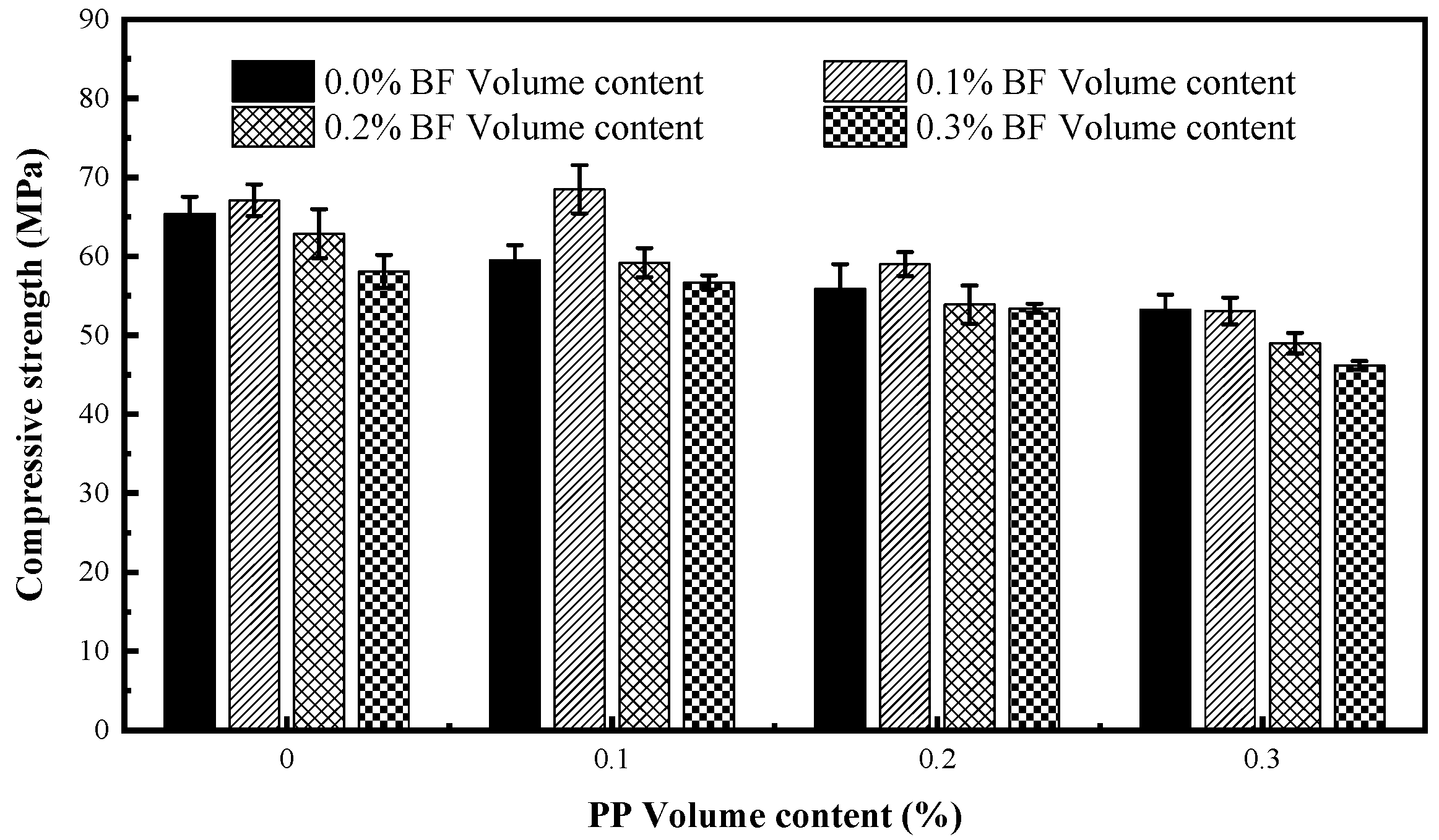
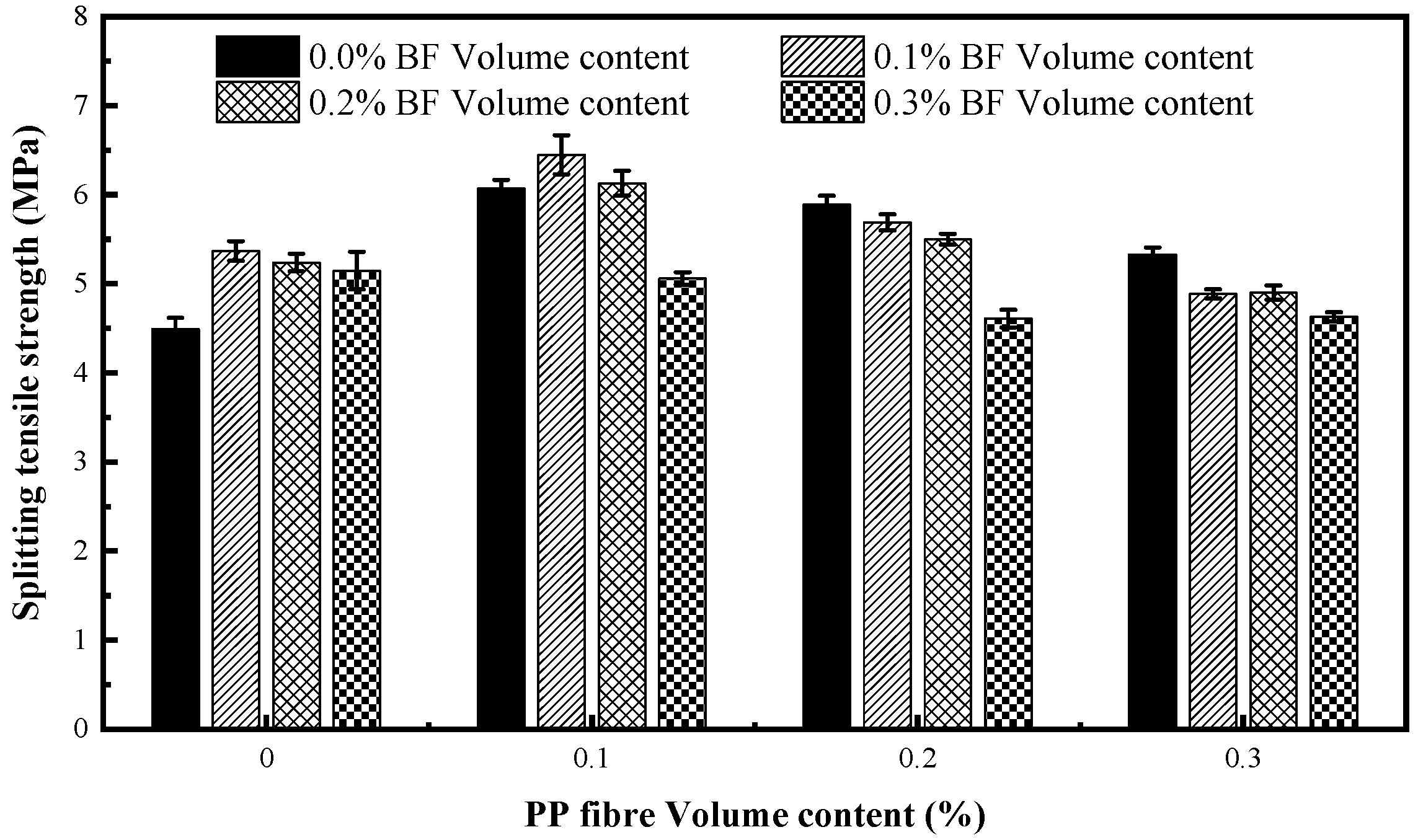
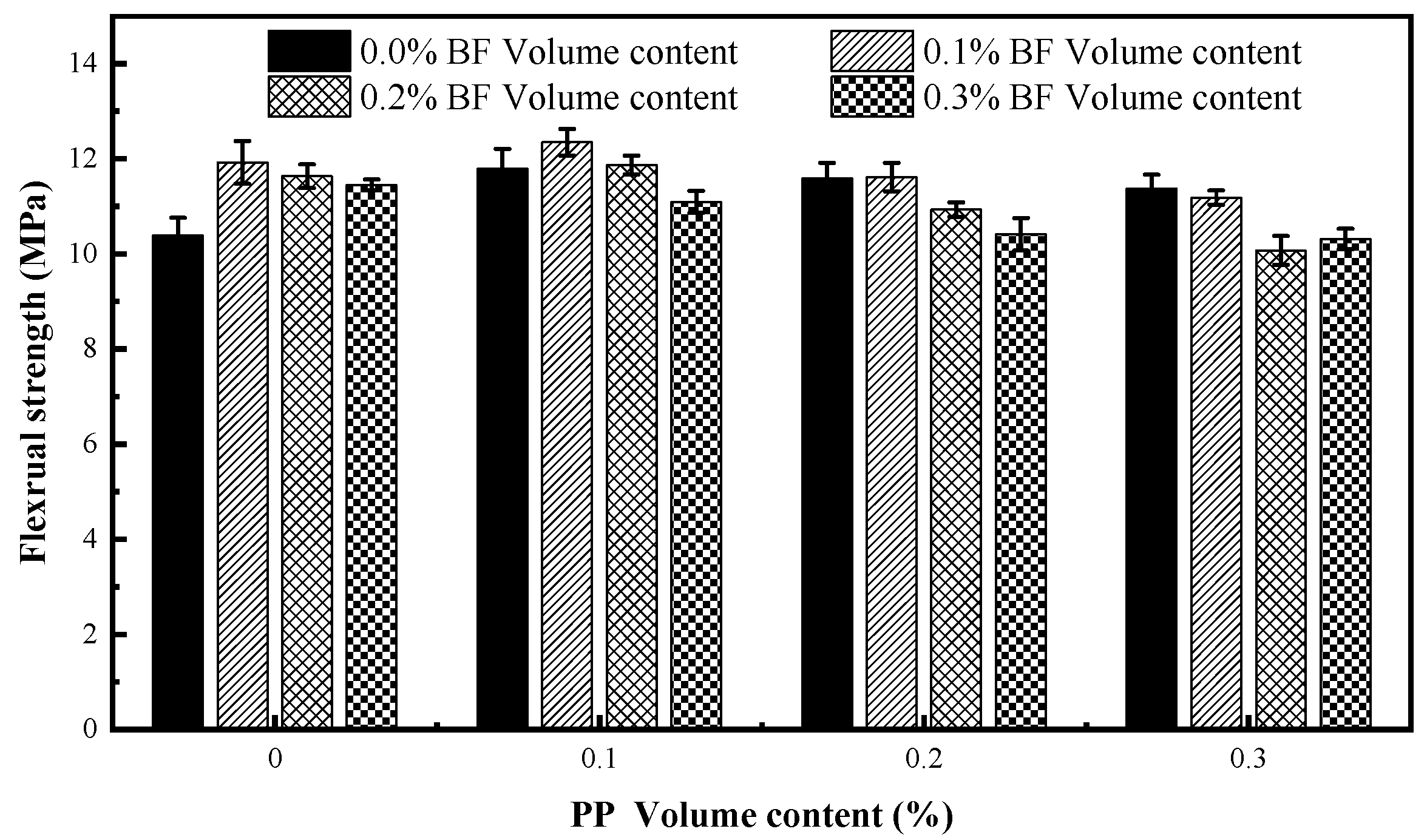
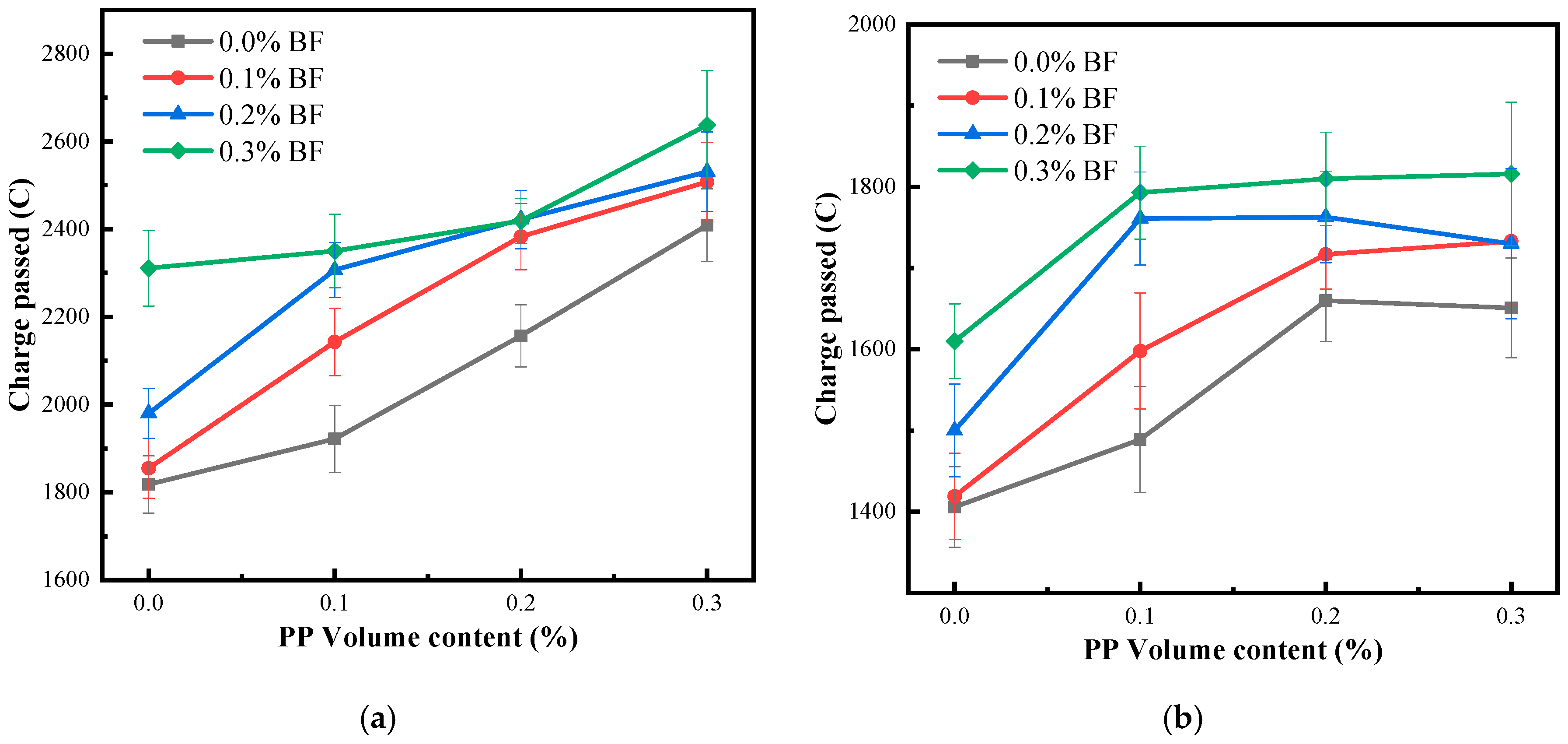
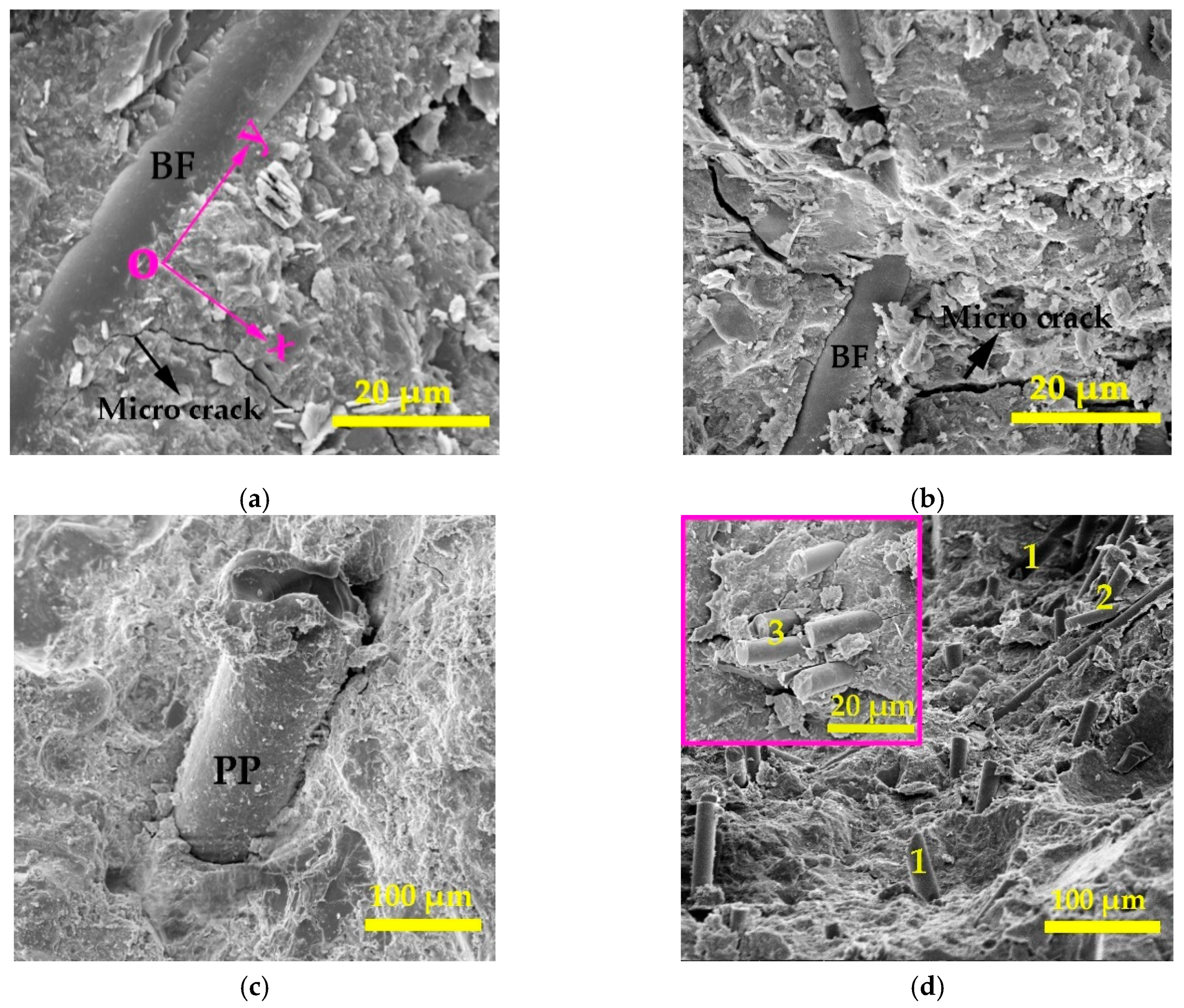
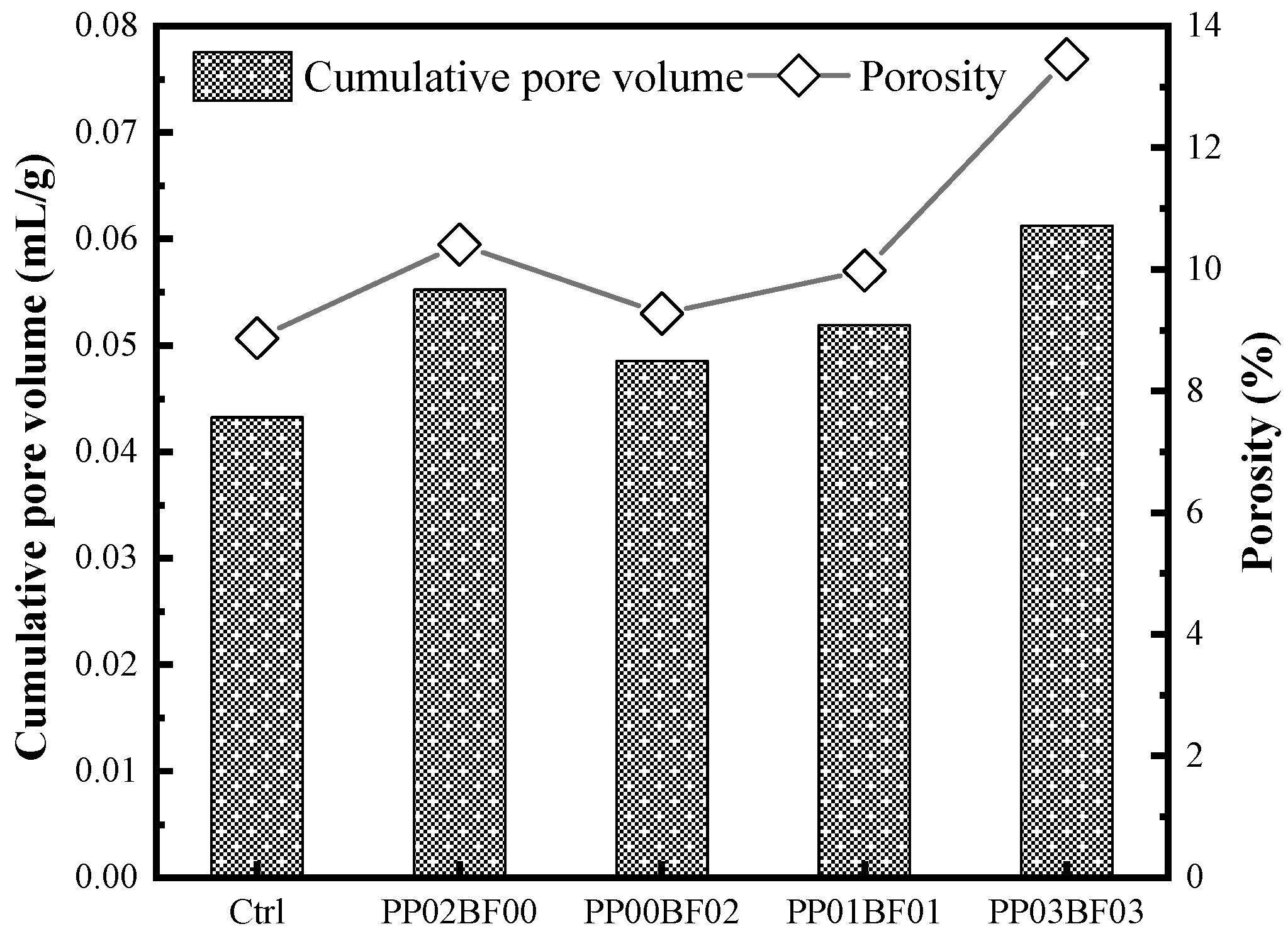
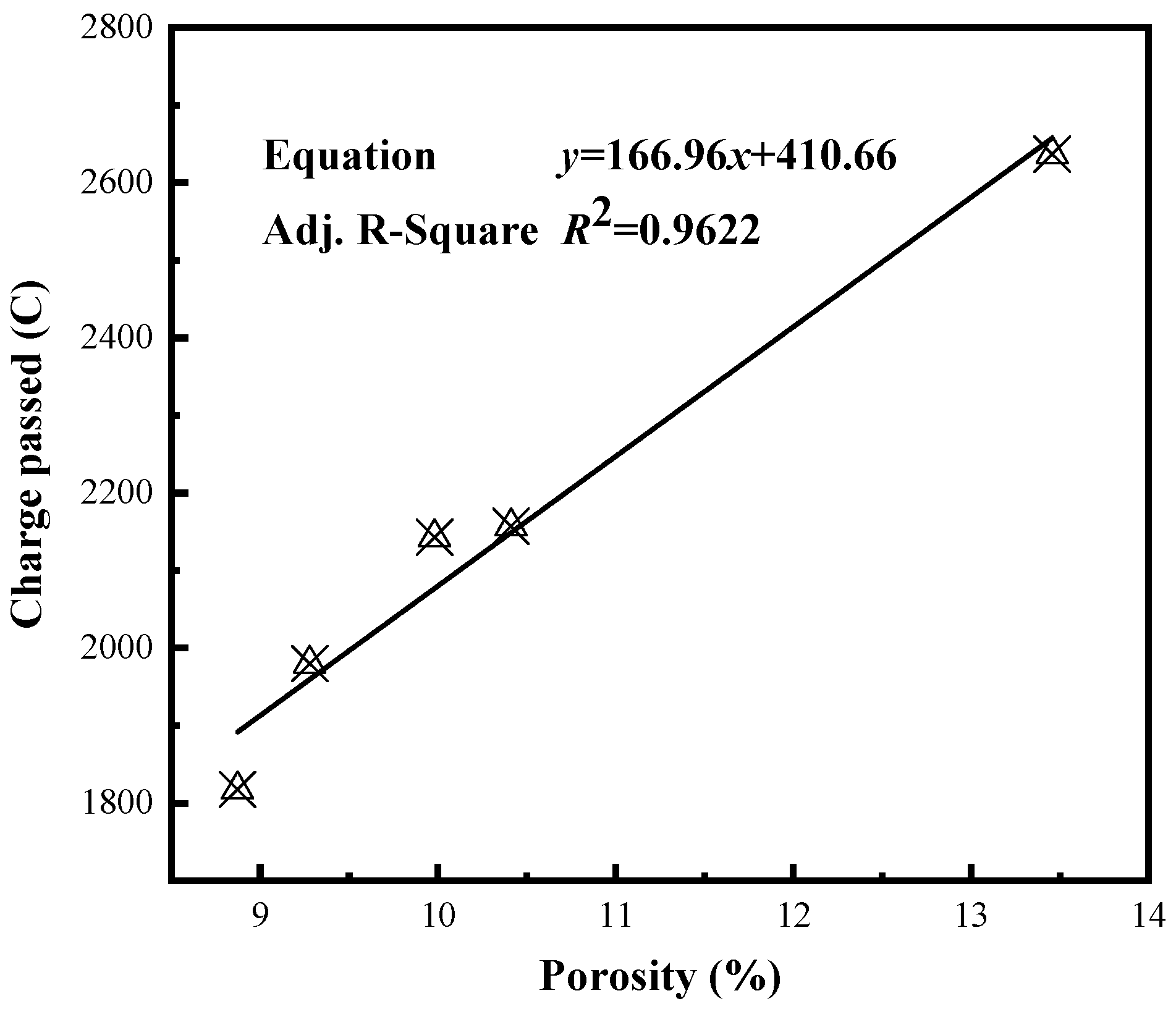
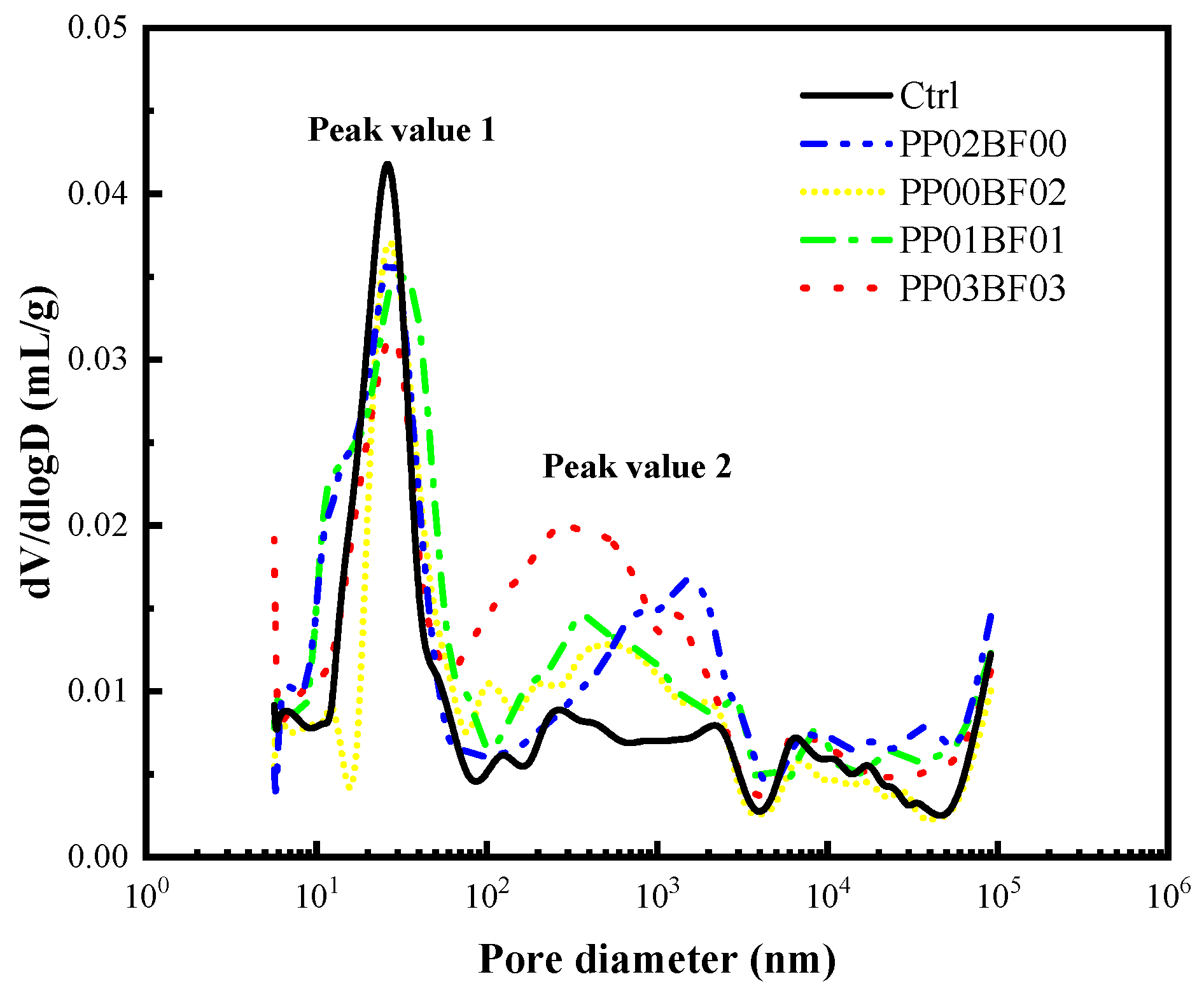
| The Chemical Composition (%) | The Physical Properties | ||||||||
|---|---|---|---|---|---|---|---|---|---|
| SiO2 | Al2O3 | Fe2O3 | Na2O | MgO | K2O | CaO | MnO | Specific Gravity (Kg/m3) | Specific Surface (m2/Kg) |
| 20.94 | 2.84 | 4.64 | 0.48 | 1.65 | 0.26 | 69.03 | 0.16 | 3150 | 350 |
| Type | Length (mm) | Diameter (μm) | Density (g/cm3) | Tensile Strength (MPa) | Elastic Modulus (GPa) | Elongation (%) |
|---|---|---|---|---|---|---|
| PP | 12 | 18–45 | 0.91 | 310–540 | 3.72 | 20 |
| BF | 12 | 16 | 2.65 | 2630 | 88.9 | 2.99 |
| Mix ID | Cement | Water | Fine Aggregate | Coarse Aggregate | SP | PP | BF | Slump |
|---|---|---|---|---|---|---|---|---|
| (Kg/m3) | (%) | (mm) | ||||||
| Ctrl | 500 | 160 | 1044 | 696 | 4 | 0.0 | 0.0 | 130 |
| PP01BF0 | 500 | 160 | 1044 | 696 | 4 | 0.1 | 0.0 | 100 |
| PP02BF0 | 500 | 160 | 1044 | 696 | 4 | 0.2 | 0.0 | 85 |
| PP03BF0 | 500 | 160 | 1044 | 696 | 4 | 0.3 | 0.0 | 65 |
| PP0BF01 | 500 | 160 | 1044 | 696 | 4 | 0.0 | 0.1 | 120 |
| PP0BF02 | 500 | 160 | 1044 | 696 | 4 | 0.0 | 0.2 | 105 |
| PP0BF03 | 500 | 160 | 1044 | 696 | 4 | 0.0 | 0.3 | 80 |
| PP01BF01 | 500 | 160 | 1044 | 696 | 4 | 0.1 | 0.1 | 100 |
| PP01BF02 | 500 | 160 | 1044 | 696 | 4 | 0.1 | 0.2 | 80 |
| PP01BF03 | 500 | 160 | 1044 | 696 | 4 | 0.1 | 0.3 | 65 |
| PP02BF01 | 500 | 160 | 1044 | 696 | 4 | 0.2 | 0.1 | 75 |
| PP02BF02 | 500 | 160 | 1044 | 696 | 4 | 0.2 | 0.2 | 65 |
| PP02BF03 | 500 | 160 | 1044 | 696 | 4 | 0.2 | 0.3 | 55 |
| PP03BF01 | 500 | 160 | 1044 | 696 | 4 | 0.3 | 0.1 | 60 |
| PP03BF02 | 500 | 160 | 1044 | 696 | 4 | 0.3 | 0.2 | 55 |
| PP03BF03 | 500 | 160 | 1044 | 696 | 4 | 0.3 | 0.3 | 50 |
| Mix ID | ||||||
|---|---|---|---|---|---|---|
| PP01BF01 | 1.011 | – | 1.033 | – | 1.018 | – |
| PP01BF02 | 0.970 | 0.998 | 1.005 | – | 1.003 | – |
| PP01BF03 | 0.976 | 0.988 | 0.910 | 0.992 | 0.970 | 0.985 |
| PP02BF01 | 0.955 | 1.048 | 0.982 | 1.028 | 0.987 | 1.001 |
| PP02BF02 | 0.924 | 0.983 | 0.965 | 1.023 | 0.970 | 0.972 |
| PP02BF03 | 0.959 | 0.978 | 0.884 | 0.951 | 0.949 | 0.955 |
| PP03BF01 | 0.884 | 0.999 | 0.955 | 0.959 | 0.968 | 0.992 |
| PP03BF02 | 0.880 | 0.963 | 0.968 | 0.959 | 0.932 | 0.943 |
| PP03BF03 | 0.893 | 0.937 | 0.950 | 0.933 | 0.950 | 0.954 |
© 2019 by the authors. Licensee MDPI, Basel, Switzerland. This article is an open access article distributed under the terms and conditions of the Creative Commons Attribution (CC BY) license (http://creativecommons.org/licenses/by/4.0/).
Share and Cite
Hu, X.; Guo, Y.; Lv, J.; Mao, J. The Mechanical Properties and Chloride Resistance of Concrete Reinforced with Hybrid Polypropylene and Basalt Fibres. Materials 2019, 12, 2371. https://doi.org/10.3390/ma12152371
Hu X, Guo Y, Lv J, Mao J. The Mechanical Properties and Chloride Resistance of Concrete Reinforced with Hybrid Polypropylene and Basalt Fibres. Materials. 2019; 12(15):2371. https://doi.org/10.3390/ma12152371
Chicago/Turabian StyleHu, Xinyu, Yihong Guo, Jianfu Lv, and Jize Mao. 2019. "The Mechanical Properties and Chloride Resistance of Concrete Reinforced with Hybrid Polypropylene and Basalt Fibres" Materials 12, no. 15: 2371. https://doi.org/10.3390/ma12152371
APA StyleHu, X., Guo, Y., Lv, J., & Mao, J. (2019). The Mechanical Properties and Chloride Resistance of Concrete Reinforced with Hybrid Polypropylene and Basalt Fibres. Materials, 12(15), 2371. https://doi.org/10.3390/ma12152371




